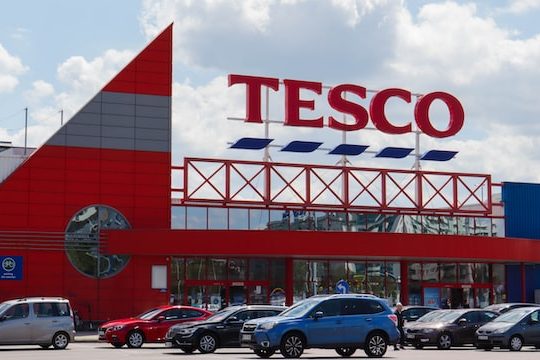Before we dive deep into the Marketing Mix, let’s get the business overview of Tesco. Tesco plc is a British multinational retail company specializing in the grocery and general merchandise sector. It was founded by Jack Cohen in 1919 and has become one of the world’s largest retailers. Tesco operates across multiple countries, with its primary market being the United Kingdom. Here’s an overview of Tesco’s business:
- Market Position: Tesco is the UK’s leading supermarket, holding a significant market share in the country’s grocery sector. It also has a strong presence in other countries, including Ireland, Central Europe, and Asia.
- Store Formats: Tesco operates various store formats to cater to different customer needs, including Extra, Superstore, Metro, Express, and One Stop. These formats range from large hypermarkets to smaller convenience stores.
- Product Range: The retailer offers a broad range of products, including groceries, clothing, household items, and electronics. It also has a robust private label offering through its exclusive brands, such as Tesco Finest, Tesco Everyday Value, and F&F.
- Online Presence: Tesco’s robust online platform allows customers to order groceries and other products through its website and mobile app. The company offers home delivery and click-and-collect services to provide convenience to its customers.
- Loyalty Program: Clubcard, Tesco’s loyalty program, rewards customers with points for their purchases, which can be redeemed for discounts, vouchers, or other benefits. This program helps Tesco maintain customer loyalty and gather valuable consumer data.
- Corporate Social Responsibility: Tesco has implemented various sustainability initiatives, including reducing food waste, minimizing plastic usage, and sourcing products ethically. It aims to become a zero-carbon business by 2050.
- Financial Performance: Tesco has demonstrated strong financial performance, consistent revenue, and profit growth. The company focuses on cost-saving measures and operational efficiency to maintain its profitability.
- Acquisitions and Partnerships: Tesco has pursued strategic acquisitions and partnerships to expand its market reach and diversify its business. Notable acquisitions include the UK food wholesaler Booker Group and the convenience store chain One Stop.
In its 2023/2024 financial year, Tesco’s annual revenue amounted to more than 61.5 billion British pounds in the United Kingdom and the Republic of Ireland.
Here is the Marketing Mix for Tesco
A marketing mix, also known as the 4Ps of marketing, is framework marketers use to develop and implement effective marketing strategies. The concept helps businesses identify and optimize the key components necessary to promote and sell their products or services. The 4Ps of the marketing mix are Product, Price, Place, and Promotion.
In addition to the traditional 4 Ps, marketers have expanded their strategies by incorporating additional elements (People, Process & Performance) to help them better understand and reach their target audiences. But we will focus on the 4Ps as they still are the foundation of any marketing strategy. In this article, we will understand the marketing mix of Tesco.
What is a Marketing Mix? What are the 4Ps of Marketing?
Product
- Broad product range: Tesco offers a wide array of products, including groceries, clothing, electronics, and household items. Their product range is designed to cater to the diverse needs of their customer base, ensuring they can find everything they need in one place.
- Own-brand products: Tesco has developed several own-brand product lines, such as Tesco Finest, Tesco Everyday Value, and Tesco Organic. These products are available at different price points, catering to various customer preferences and budgets.
- Quality assurance: Tesco maintains high-quality standards for its products by sourcing from reputable suppliers, ensuring its offerings meet or exceed customer expectations.
- Convenience products: Tesco also provides a range of convenience products, such as ready-to-eat meals, snacks, and drinks. These items cater to customers with busy lifestyles who need quick and easy meal solutions.
- Non-food items: Besides food products, Tesco also sells non-food items like clothing, electronics, and household products. This diversifies their product range and provides a one-stop shopping experience for customers.
- Online shopping and home delivery: Tesco has a solid online presence, allowing customers to shop for their products from the comfort of their homes. They offer home delivery services, making it easy for customers to receive their purchases.
- Sustainability and environmental concerns: Tesco is committed to reducing its environmental impact and promoting sustainable practices. The company has introduced eco-friendly products and packaging options for environmentally conscious customers.
Price
- Competitive pricing: Tesco strives to offer competitive prices for its products to attract price-conscious customers. The company actively monitors and compares its prices with its competitors to ensure they remain competitive and provide good value for money.
- Own-brand products at various price points: Tesco has developed a range of own-brand products at different price points to cater to customers with varying budgets. For example, Tesco Finest offers premium-quality products at a higher price, while Tesco Everyday Value targets budget-conscious customers with lower-priced products. This approach allows Tesco to appeal to a broad range of customer segments.
- Price promotions: Tesco frequently offers price promotions, discounts, and special offers to attract customers and boost sales. These promotions can include multi-buy deals, limited-time discounts, and seasonal offers. By employing such promotional pricing strategies, Tesco incentivizes customers to purchase and enhances customer loyalty.
- Clubcard loyalty program: Tesco’s Clubcard loyalty program rewards customers with points for their purchases, which can be redeemed for discounts on future shopping. This program encourages customer loyalty by providing price benefits to regular shoppers, making them more likely to choose Tesco over competitors.
- Dynamic pricing for online shopping: Tesco’s online shopping platform may employ dynamic pricing strategies based on demand, stock levels, and competitor prices. This allows the company to optimize its pricing for maximum profitability while still remaining competitive in the market.
- Price perception: Tesco works to maintain a positive price perception among customers by emphasizing the value and quality of its products. The company communicates its commitment to offering good value through marketing campaigns and in-store signage.
Place
- Store locations: Tesco has a widespread network of stores across the United Kingdom and other countries. The company strategically chooses its store locations to ensure easy accessibility for customers, considering factors such as population density, customer preferences, and competitor presence.
- Store formats: Tesco operates a variety of store formats to cater to different customer needs and preferences. These formats include Tesco Extra (large hypermarkets), Tesco Superstores (medium-sized supermarkets), Tesco Metro (small urban supermarkets), and Tesco Express (convenience stores). This diverse range of store formats allows Tesco to serve customers in various environments, from busy city centers to suburban neighborhoods.
- Online shopping: Tesco has a strong online presence, offering customers the convenience of shopping for their products from the comfort of their homes. The company’s e-commerce platform is user-friendly and supports home delivery and click-and-collect services, allowing customers to choose the most convenient method for receiving their purchases.
- Click-and-collect service: Tesco’s click-and-collect service enables customers to place orders online and pick them up at their nearest store, saving them time and offering added convenience. This service caters to customers with busy lifestyles and those who prefer not to wait for home delivery.
- Supply chain and logistics: Tesco has an efficient supply chain and logistics system in place to ensure that products are readily available at its stores and online. The company invests in technology and works closely with suppliers to optimize inventory management and distribution processes, which helps maintain product availability and freshness.
- International presence: Tesco has expanded its operations beyond the UK, with stores in several countries across Europe and Asia. This global presence allows the company to reach new markets and diversify its customer base.
Promotion
- Advertising: Tesco uses different advertising channels, such as television, radio, print, and online media, to reach its target audience and promote its products, offers, and brand values. The company creates engaging advertisements highlighting product features, prices, and special promotions to capture customer attention.
- In-store promotions: Tesco frequently runs in-store promotions, such as special offers, discounts, and multi-buy deals, to encourage customers to purchase. These promotions are displayed prominently in stores, using point-of-sale materials like banners, shelf labels, and posters to draw attention to the offers.
- Public relations: Tesco engages in public relations activities to maintain a positive brand image and build relationships with customers, the media, and other stakeholders. These activities may include press releases, media events, and community involvement, such as sponsoring local events or supporting charitable causes.
- Social media and digital marketing: Tesco utilizes social media platforms like Facebook, Twitter, and Instagram, as well as email marketing and online advertising, to engage with customers, share news and promotions, and provide customer support. This digital presence allows the company to communicate with a broader audience and build a strong online community.
- Clubcard loyalty program: Tesco’s Clubcard loyalty program rewards customers with points for their purchases, which can be redeemed for discounts on future shopping. This program encourages customer loyalty and serves as a promotional tool, as customers are more likely to shop at Tesco to earn and redeem points.
- Sponsorship and partnerships: Tesco may engage in sponsorships and partnerships with other brands, events, or organizations to increase brand visibility and reach new audiences. These collaborations can enhance Tesco’s brand image and create positive associations in customers’ minds.
- In-store experiences: Tesco creates positive in-store experiences through well-organized store layouts, helpful staff, and attractive product displays. These factors create a pleasant shopping environment, encouraging customers to return and make repeat purchases.











